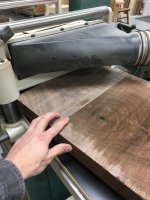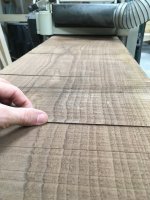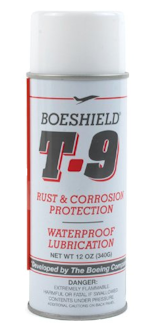RobS888 said:
Have you jointed the other side?
I have a 12 inch jet combo machine with a spiral head and I start pretty light at first with roughsawn wood, first or second pass may not take anything off.
Yep, bottom side is jointed flat and smooth.
I start with a very light cut. Still gets hung up.
JD2720 said:
Is it that rough on both sides? If it is, that is your problem. You need to smooth up one side some. I run 1 side across the jointer.
My guess is that the high spots are getting caught on the edge of the infeed table or in the bed roller slots.
If you do not have a jointer the right size for smoothing one face, you could runs it through your wide sander.
I consider running it through the drum sander. Having a conveyor belt, the drive isn't influenced by a rough surface. Bottom has been jointed.
Mike Goetzke said:
I have that planer with spiral cutter head. Never had a feed issue...unless I tried to chew too much off in one pass. I too was wondering if this is rough on the other side since looks like you are using some kind of a sled. Other than that have you adjusted the rollers and have sharp cutters?
Cutters are helical and recently rotated to a new edge.
Oldwood said:
I would check a few thing first to insure your planer is set properly.
The first is to check the bed for flat with a straight edge. I had a 20" version of that style of planer that had a warped bed. One in-feed corner was high and it made it hard to feed stock through.
Next check to insure the bed rollers are set correctly. For most finish work I think the setting should be about .005" up from the bed but if you plane a lot of rough stock you could bring them up a bit.
Also make sure the bed is clean and waxed.
The segmented feed rollers allow you to feed stock of various thicknesses but I don't think they would help this situation.
You also need to insure your feed rollers are set correctly. They are set below the arc of the cutters by a given amount that is described in the owners manual. I made a block of wood that sat on the bed and would be aligned with bottom arc of the cutter. Then you drop the bed the amount required and align the in feed and out feed rollers. I imagine you have done these thing but just in case you have not it is worth mentioning. You also need to set the spring tension and that is done with the four screws on the top of the planer. You should set the according to the manual but a little extra is all right if you plane a lot of rough material. Too much pressure on the out feed will result in the roller marking the wood.
The board in the picture with the step from the band saw look extreme and you might consider either running that side up with the first pass or hitting those steps with a hand plane to smooth it a bit first.
The big planers have a lever on the front that will adjust all bed roller up or down quickly. These plane don't do as well with very rough stock but can be made to work well enough if set correctly.
Good luck with it.
This may be where it gets tricky. I'm using a single piece of melamine over the bed. The reason was to help eliminate snipe. Perhaps the melamine is getting sticky and for rough material I'm better not using it. I'll try that.
I hate setting up the rollers. So fiddly on this machine!
Yes, the board is rough. The recent batch from my supplier had some bad ones. But too wide and beautiful to pass up.
Tom Gensmer said:
Agree with the above, in particular you'd be well served to either joint the reference face prior to planing, or use a melamine sled to reduce friction. I assume you don't have a 16" jointer, if this is the case then using the sled and some shims would allow you to use your planer to joint one face, then flip the board over to thickness it.
It's also possible that, if the board is wedge-shaped, it may be small enough to enter the machine, but if it increases in thickness it will eventually bind up and stall the machine. Best to measure thickness at multiple locations prior to your first pass....
Yep, sometimes I start off ok, the board gets jammed at the infeed, so I back the table down. This isn't that. I wish I had a 16" jointer, but my 8" works good using the sled trick afterwards on the planer.
Alanbach said:
Since apparently you normally have good results from your planer and are just experiencing this problem with rough timber my bet is that your problem is isolated to the bed rollers not being set quite high enough. Try raising them a bit.
I think this is what I need to do, thanks. Remove my melamine bed extension and raise the rollers. Or run the board a couple times through the drum sander with P24 grit to hit the high spots off.
Thanks everyone for chiming in so far!




